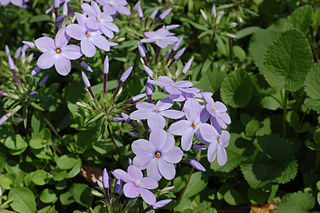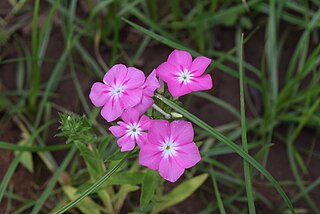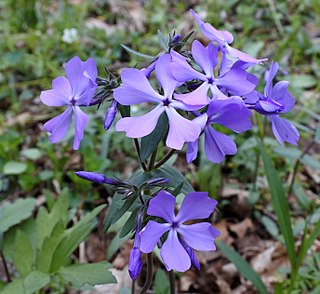
Phlox is a genus of 68 species of perennial and annual plants in the family Polemoniaceae. They are found mostly in North America in diverse habitats from alpine tundra to open woodland and prairie. Some flower in spring, others in summer and fall. Flowers may be pale blue, violet, pink, bright red, or white. Many are fragrant.

Phlox stolonifera is a species of flowering plant in the family Polemoniaceae. It is a perennial herbaceous plant that is native to the eastern United States. It occurs in woodlands and stream banks in the vicinity of the Appalachian Mountains from Pennsylvania south to northern Georgia. Naturalized populations occur as far north as Québec, Canada.

The Polemoniaceae are a family of flowering plants consisting of about 25 genera with 270–400 species of annuals and perennials native to the Northern Hemisphere and South America, with the center of diversity in western North America.

Phlox drummondii is a flowering plant in the genus Phlox of the family Polemoniaceae. Native to Texas, it is also widely distributed in the southeastern United States, especially along public highways. P. drummondii is often used as an ornamental plant. The flowers have a wide range of colours "from white and cream through pinks, lilacs, roses, purples and reds, to almost black".

Phlox subulata the creeping phlox, moss phlox, moss pink or mountain phlox, is a species of flowering plant in the family Polemoniaceae, native to eastern and central USA, and widely cultivated.

Phlox divaricata, the wild blue phlox, woodland phlox, or wild sweet william, is a species of flowering plant in the family Polemoniaceae, native to forests and fields in eastern North America.

Phlox nivalis is a species of flowering plant in the Polemoniaceae family, it is commonly known as the trailing phlox, but other common names include Pineland phlox, Pine phlox, and sweet trailing. It is native to the southeastern states, along with Texas, Utah, and Michigan.

Aliciella is a genus of plants in the phlox family. These plants have been treated as members of genus Gilia until recently, when it was proposed they be moved back to Aliciella. This genus was created in 1905 to include certain gilias that seemed distinct from most of the others, but it was abandoned soon after. Recent genetic analyses suggest it should be revived.

Phlox adsurgens, the northern phlox, is a species of flowering plant in the family Polemoniaceae. It is native to the US, in Oregon and a section of the northern Coast Ranges of California, where it belongs to the flora in forested and wooded mountain habitat. This decumbent herbaceous perennial has erect branches up to 30 centimeters (1 ft) long. The oval leaves are 1 to 3 centimeters long and oppositely arranged in pairs. The inflorescence is a cluster of five-lobed pink flowers.
Phlox dolichantha is a species of phlox known by the common name Big Bear Valley phlox. It is endemic to San Bernardino County, California, where it is limited to the area around Big Bear Lake in the San Bernardino Mountains. It grows in forests and the unique local pebble plain habitat. It occurs at elevations over 2000 meters. It is an erect, branching perennial herb growing up to 30 centimeters tall. The linear or narrowly lance-shaped leaves are 2 to 5 centimeters long and are oppositely arranged on the slender stems. The inflorescence is made up of one or more showy flowers at the tip of the stem. Each flower has a very slender tubular throat up to 5 centimeters long which can be white, pink, or lavender.

Microsteris is a monotypic genus of flowering plants in the phlox family containing the single species Microsteris gracilis, known by the common name slender phlox.

Saltugilia is a genus of flowering plants in the phlox family, Polemoniaceae. They are known commonly as woodland gilias. There are four species. Two are endemic to California in the United States, and the distributions of the other two extend into Baja California in Mexico.

Phlox bifida, commonly known as cleft phlox or sand phlox, is a perennial herbaceous plant in the Polemoniaceae (phlox) family that is native to the central United States.

Aliciella latifolia, also known as broad-leaved gilia, is a foul smelling annual plant in the Phlox family (Polemoniaceae) found in deserts of the southwestern United States.
Phlox tenuifolia, the Santa Catalina Mountain phlox, is a white flowered plant in the phlox family (Polemoniaceae) that can be found with stems climbing through shrubs and other vegetation growing on rocky slopes of the Sonoran Desert in Arizona. Botanist Richard Spellenberg has described its floral displays over supporting vegetation as "spectacular".
Phlox oklahomensis, the Oklahoma phlox, is a species of flowering plant in the family Polemoniaceae. It can be found in the prairies of Kansas, Oklahoma and Texas.

Phlox maculata, common names wild sweetwilliam and meadow phlox, is a species of flowering plant in the family Polemoniaceae, native the eastern United States and introduced to eastern Canada. It is a perennial.

Phlox sibirica, the Siberian phlox, is a species of flowering plant in the family Polemoniaceae, native to eastern European Russia, most regions of Siberia, northern parts of the Russian Far East, Mongolia, and Alaska.
Phlox roemeriana, the goldeneye phlox, is a species of flowering plant in the family Polemoniaceae, native to Texas. There it is found only on dry limestone soils of the Edwards Plateau and nearby areas of the High Plains. An annual reaching 13 cm (5 in), it has pink flowers with a yellow center.
Phlox cuspidata, the pointed phlox, is a species of flowering plant in the family Polemoniaceae, native to the US states of Oklahoma, Texas, and Louisiana. An annual reaching 25 cm (10 in), its hybridization dynamics with and partial reproductive isolation from Phlox drummondii are the subject of scientific inquiry.














